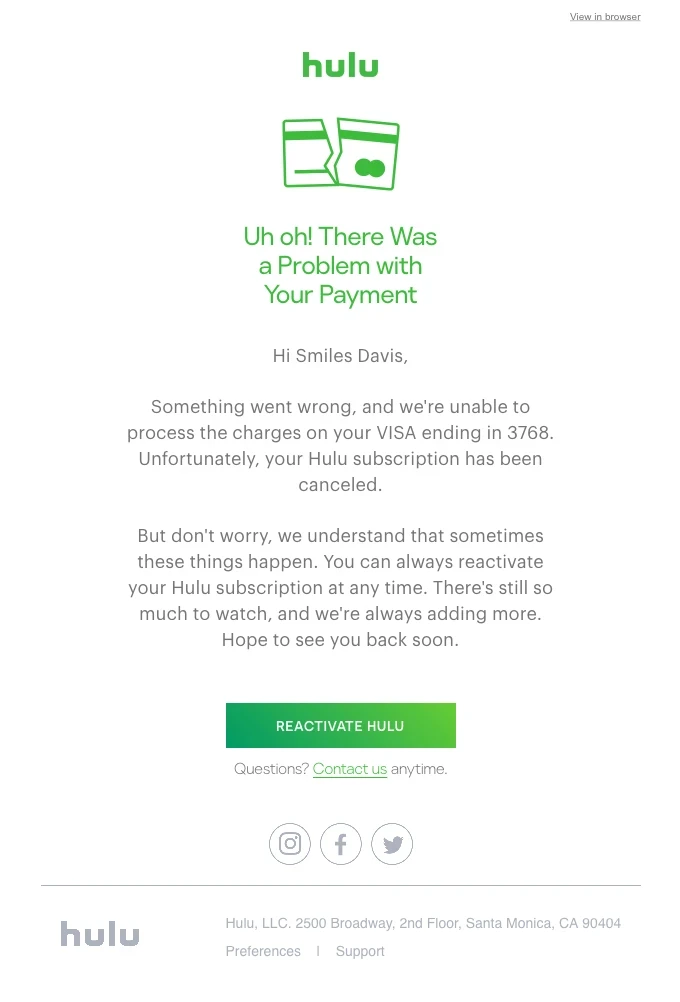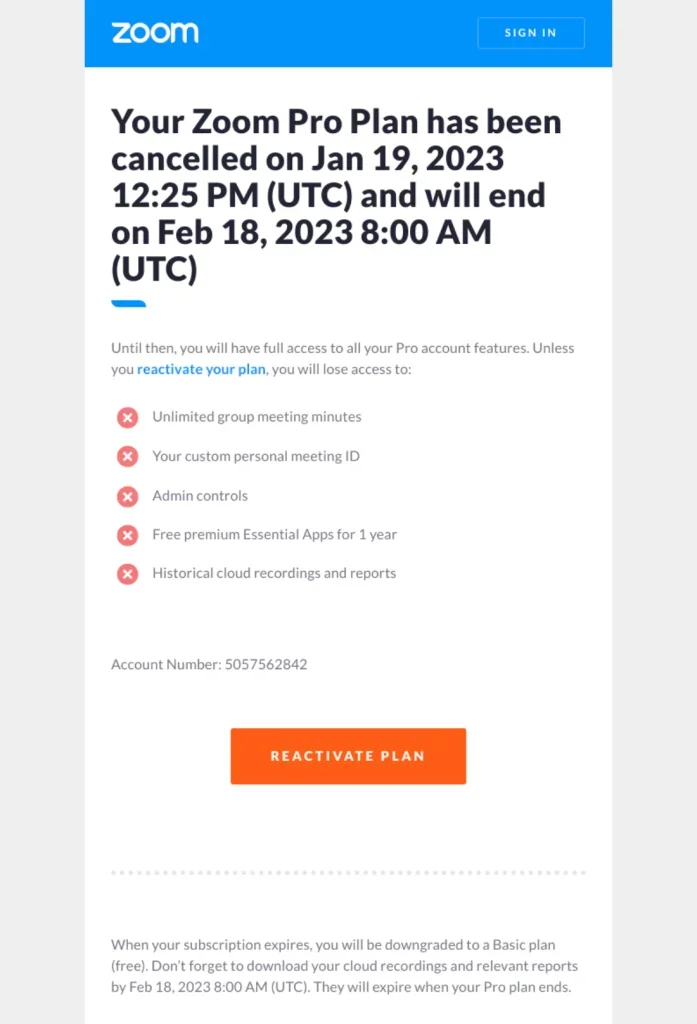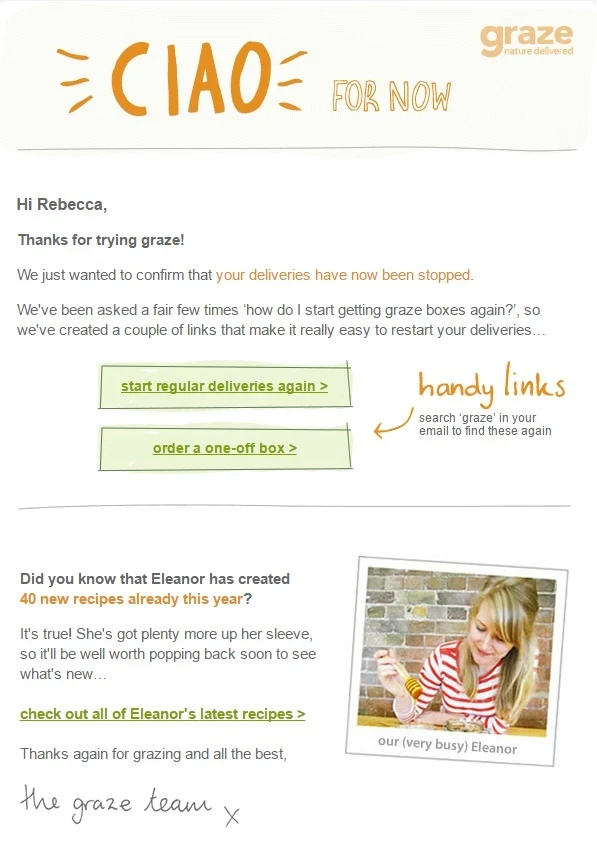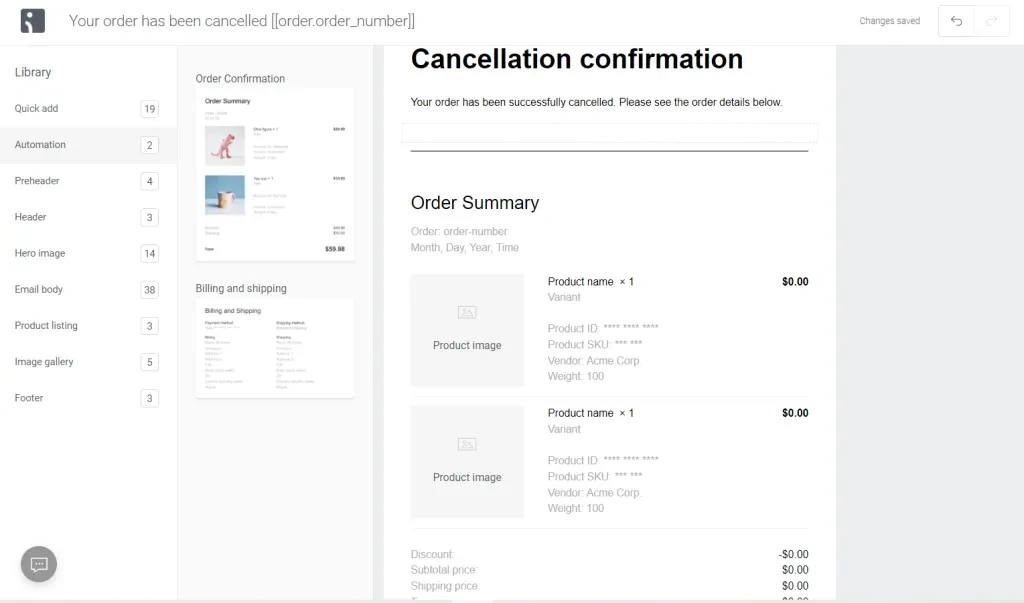Many ecommerce merchants think order cancellation emails are nothing more than a necessary evil, initiated after losing an order.
But savvy online retailers know that cancellation confirmation messages present a golden opportunity to reconnect with customers. In fact, they can actually enhance brand reputation.
With the right tone and helpful content, these emails can win back sales. They can also reduce cancellations and strengthen customer relationships.
This article will show you how to write effective order cancellation emails that boost your ecommerce success. We also share some best practices and examples to inspire you.
Ready to transform the way you handle order cancellations? Read on!
Table of Contents
Why order cancellation emails are important
Common reasons for order cancellations
Best practices for cancellation confirmation emails
Order cancellation email templates
Wrap up
Why order cancellation emails are important
Order cancellations are a reality of ecommerce. They can be a double-edged sword—both a challenge and an opportunity for businesses.
As such, understanding their value is critical to growing as an online business. Here’s why making the most of your cancellation confirmation emails can be invaluable:
- Facilitate returns. Order cancellation emails ensure any needed refunds or returns are handled smoothly. Be courteous, empathetic, and professional to show respect for your customers’ decisions. This enhances their post-purchase experience.
- Build goodwill. Cancellation emails show customers that you care, even when they cancel an order. This builds goodwill and keeps the door open for future business. Be consistent in branding, tone, and professionalism to reinforce your brand image.
- Get feedback. Order cancellation emails provide a chance to find out why the customer canceled. You can then remedy issues like checkout problems, shipping costs, or product details. Communicate effectively to prevent frustrated clients from venting through negative reviews.
- Encourage repurchases. Cancellation confirmation emails can persuade customers to complete their purchase after all. With the right tone and content, they can suggest alternative products or solutions. This retains customer interest while increasing the value of the order.
- Get consumer insights. An order cancellation email can help you collect data and improve your business. Include a survey to find out why customers canceled their orders. You can also rate how satisfied they were with your service and what you can do to improve. These invaluable insights can help you optimize your products, services, and marketing strategies.
- Gain competitive advantage. Delivering a superior cancellation confirmation experience can set your brand apart. It can also increase the chances of your clients buying from you again or recommending you to others. This is crucial in today’s crowded ecommerce market.
- Compliance and documentation. These emails serve as official records of order cancellations. As such, they aid in compliance and record-keeping for both customers and businesses.
In essence, order cancellation emails aren’t merely transactional email notifications. They’re essential tools for nurturing customer relationships and resolving issues. Master the art of crafting these emails to achieve ecommerce success.
Common reasons for order cancellations
Order cancellations can originate from either the customer or the seller.
Regardless of who initiates it, it’s important for merchants to send a cancellation confirmation email in every case. You can even set them up as trigger emails to keep customers informed and maintain a positive experience.
Some common reasons for order cancellations include:
1. Out of stock
An item may become unavailable between order and fulfillment. This can happen due to inventory errors, high demand, or supplier issues. When it does, it’s important to inform the customer as soon as possible, as Nordstrom illustrates.

A cancellation email with an apology and alternate suggestions retains goodwill. Offer them alternatives, such as a similar product, a backorder option, or a refund.
2. Shipping delays
Sometimes, orders take longer than expected to arrive. This can be due to carrier problems, weather conditions, or customs clearance. There might even be issues like invalid addresses or restrictions on certain items.
Shipping delays can cause customers to lose interest or confidence in their purchase and request a cancellation. Email confirmations should smooth the way for corrected reorders.
3. Payment issues
Problems, like declined credit cards, fraudulent transactions, or chargebacks, can result in cancellations. There might even be issues with online payment processing. Take a look at how Hulu does this type of email.

These situations can be frustrating for both the seller and the customer. As such, they require careful verification and communication. Confirmation emails should clarify the issue and provide a way forward.
4. Customer request
Customers may simply change their minds or alter their preferences. They may have selected the wrong item or need to make a quantity adjustment. Customers might even decide the purchase is no longer needed or affordable.
Here’s how Zoom responded to a customer’s cancellation request.

Allowing cancellations upon request, with no hassle, is important for good customer service.
5. Package lost or damaged during shipping
While the logistics teams handle products most of the time, accidents may happen. Sometimes an order might be canceled by the ecommerce brand because the package was misplaced or damaged during shipping and can’t be replaced.
6. Seller discretion
Sellers may also cancel orders due to factors like fraudulent activity or pricing errors. In case you have to investigate such issues, issue a cancellation notice outlining the next steps.
Cancellation confirmation emails provide transparency and demonstrate professionalism in handling cancellations. They can also be an opportunity to improve customer satisfaction and retention.
Best practices for cancellation confirmation emails
Crafting effective cancellation confirmation emails requires finesse.
But doing it right addresses customer concerns and maintains their trust and goodwill.
Follow these best practices to turn order cancellations into positive customer experiences:
1. Use clear and concise subject lines. Use subject lines that clearly convey the purpose of the email. For example, “Order Cancellation Confirmation” or “Your Order Cancellation Request.”
2. Personalize the message. Address the customer by name and reference specific order details. Personalization adds a human touch and shows care and attention.
3. Be on time. Send confirmation emails as soon as possible after the cancellation request. Do it preferably before or after refund processing. This way, customers know what to expect and when to receive their money back.
4. Explain the reason for cancellation. Be transparent about why the cancellation occurred. Transparency builds trust and helps customers understand the situation. It also demonstrates respect for the customer.
5. Suggest alternatives. Whenever possible, suggest alternative products or solutions that may meet the customer’s needs. This proactive approach can turn a cancellation into a new purchase opportunity.
6. Follow legal and compliance considerations. Adhere to the consumer protection laws and regulations in your country or region. Be transparent in your refund policies and terms and conditions.
7. Manage expectations. Clearly communicate the expected timeline for refunds or credit processing. Set realistic expectations to prevent frustration and anxiety among customers.
8. Provide contact information. Include phone numbers, email addresses, and live chat links to support further communications. Make it easy for customers to reach out if they have questions or concerns.
9. Use a courteous tone. A polite, gracious, and professional tone can smooth out disappointment from the cancellation. Empathize with the customer’s situation and express regret for any inconvenience caused. And remember, a grateful tone can always calm down agitated customers.
10. Include detailed order information. Recap relevant order details like its number, items canceled, and any associated costs. This reinforces the customer’s confidence that you’re addressing the correct order.
11. Optimize your email for mobile. Ensure your email is mobile-responsive as many customers access their emails on smartphones. A well-formatted email enhances readability and user experience.
12. Include a CTA. End the email with a clear CTA, such as “Explore similar products.” This encourages customers to stay engaged with your store.
Transform cancellation confirmation emails from routine notifications into opportunities to strengthen customer relationships. Handle them well, and you’ll enhance shopping experiences and recover potentially lost sales.
Here’s an example of a cancellation confirmation email that hits all the right spots:

Order cancellation email templates
Cancellation emails should clearly communicate key details. These include order information, reason for cancellation, refund timing, and contact options.
You want to avoid confusion, frustration, and negative feedback from your customers.
Using a marketing automation platform like Omnisend makes it easy to automate cancellation confirmation. With just a few clicks, you can quickly merge tags, auto-populate customers, and order details.
Additionally, pre-made templates provide the right structure and wording. Here’s an example from Omnisend to illustrate.

But even without automation, merchants can craft effective cancellation messages. Just follow these guidelines:
- Brief greeting and notification of the cancellation
- Order number, date, and amount
- Clear explanation of why the order was canceled
- Next steps for refunds or returns
- Apology and alternate product suggestions
- Links and contact info for support
- Closing thank you and invitation to order again
Use a courteous tone, be transparent, and provide helpful options. Doing so can turn a canceled order into a positive customer experience.
Here’s how you might craft your own cancellation confirmation email:
Subject: [Your Company Name] – Order Cancellation
Hi [Customer’s Name],
We’re sorry to let you know that your order #[Order Number] has been canceled due to [Reason]. We apologize for any inconvenience this may have caused you.
Here are the details of your canceled order:
– Order Number: [Order Number]
– Order Date: [Order Date]
– Total Amount: [Order Amount]
You will receive a full refund within [X business days]. If you have any questions, please contact us at [Customer Support Email] or [Customer Support Phone Number].
We appreciate your business and hope to see you again soon. In the meantime, check out these alternative products that might interest you:
[Product 1 Image] [Product 1 Name] [Product 1 Price]
[Product 2 Image] [Product 2 Name] [Product 2 Price]
[Product 3 Image] [Product 3 Name] [Product 3 Price]
Thank you for choosing [Your Company Name].
Sincerely,
[Your Name]
[Your Position]
[Your Company Name]
Wrap up
Order cancellation emails represent a significant opportunity for ecommerce businesses.
As such, understanding why they’re sent is important. This will help you address common reasons for cancellations, build trust, and nurture loyalty.
Consider best practices when crafting cancellation confirmation emails. These include personalization, courtesy, transparency, and managing customer expectations.
Done right, you’ll recover lost sales, reduce future cancellations, and strengthen customer loyalty.
Source from Omnisend
Disclaimer: The information set forth above is provided by Omnisend independently of Alibaba.com. Alibaba.com makes no representation and warranties as to the quality and reliability of the seller and products.







